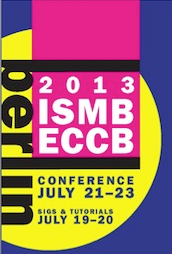 Earlier this week we were lucky enough to attend the annual Intelligent Systems for Molecular Biology meeting in Berlin, an excellent venue for deep dives into computational biology.
Earlier this week we were lucky enough to attend the annual Intelligent Systems for Molecular Biology meeting in Berlin, an excellent venue for deep dives into computational biology.
Many of the great talks at this event were held within the SIG (Special Interest Group) meetings on topics as diverse as network biology, SNPs, structural bioinformatics, and integrative RNA biology. But as expected, the keynotes were terrific as well.
The opening keynote came from Gil Ast of Tel Aviv University and provided a fascinating look at alternative splicing, epigenetics, and chromatin organization. Ast noted that 95% of genes have been found to undergo alternative splicing, with as many as 10 isoforms per gene corresponding to tremendous transcriptional diversity. Almost half of alternative splicing occurs in the form of exon skipping, Ast said. Interestingly, vertebrates are the group that appears to have the highest form of alternative splicing, with humans having the most within the group.
On a broader level, what we really took from Ast’s talk was the importance of having wet labs and computational groups working together to form a solid testing/validation loop. That’s something we value the importance of at DNAnexus, too, which is why we have designed our platform to enable bioinformatics experts to work closely with collaborators who may be less comfortable with the computational side.
Another comment that really captured our own view came from Goncalo Abecasis at the University of Michigan, who told attendees in his keynote presentation that data is not the same as understanding. That sounds simple enough. However, there’s nothing simple about transforming data into knowledge. One of the key drivers of the DNAnexus platform is the concept that it should be easier for scientists to pull knowledge out of their data; we strive to simplify data analysis and management by offering an easy-to-use interface on top of infrastructure that we maintain so our users can efficiently find the answers to their research questions. Our goal in establishing a repertoire of available apps that anyone can select and arrange in a custom workflow also allows researchers to stay focused on creating knowledge from data by reducing the time required to create the optimal analysis pipeline.
We were glad to get the opportunity to speak with so many IT developers at ISMB about our new app program, which aims to deliver new genomics tools to our user community. Anyone is welcome to apply to participate in this program; we are providing members with an initial $1,000 credit for use in accessing cloud-based storage and computational resources and free technical support from the DNAnexus engineering team. Contact us at developers@dnanexus.com to learn more.

.png)
.png)
.png)